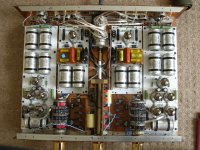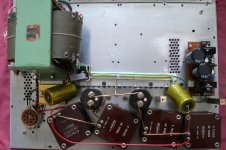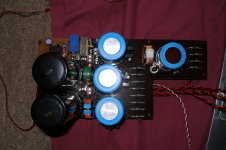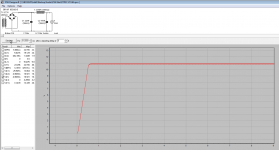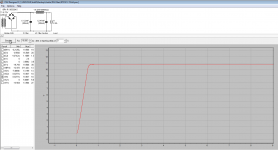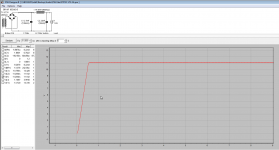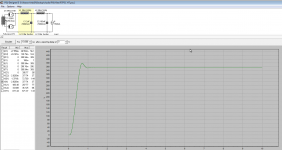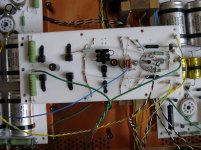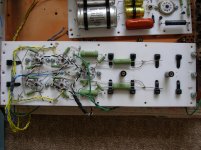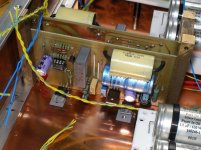Hi airtangent thanks for your post.
I only ask for a substitude in case of a damage because it`s hard to get a MAT02 or the SSM2220 (as reserve).
I have build in the MAT02.
Since my last post i have matched the BF245 with the circuit in the cook book.
Powersupply is tested and ready.
Next week i have time to make the last wiring in the amp.
I hope it will work as intended.
Chiao
Roland
I only ask for a substitude in case of a damage because it`s hard to get a MAT02 or the SSM2220 (as reserve).
I have build in the MAT02.
Since my last post i have matched the BF245 with the circuit in the cook book.
Powersupply is tested and ready.
Next week i have time to make the last wiring in the amp.
I hope it will work as intended.
Chiao
Roland
Hi airtangent thanks for your post.
I only ask for a substitude in case of a damage because it`s hard to get a MAT02 or the SSM2220 (as reserve).
Not such a big problem, you can still find them on ebay from several Hongkong based sellers.
airtangent
I have build in the MAT02.
Since my last post i have matched the BF245 with the circuit in the cook book.
Powersupply is tested and ready.
Next week i have time to make the last wiring in the amp.
I hope it will work as intended.
Chiao
Roland
Hi RTP3D builders,
I am currently starting with the planning for building and RTP3D. I red the thread, browsed the net and haven't found information about the Power Supply, but there are still a lot of unclear parts for me.
Therefore I like to ask following questions:
- I saw on the schematic a LL1628 Choke, but on some picture a LL1685.
I asked Lundahl about that, but they don't know anything about the LL1628. Some thoughts?
- Heater Choke (6mH/12mH)
I can't figure out which brand to use. Anyone any hints?
- Trafo for TR2 (100VA/420V)
Seems on the pictures like it is the same brand as the heater choke. But I can't figure out what it is
Any hints or ideas would be very welcome!
Many thanks, Tom
I am currently starting with the planning for building and RTP3D. I red the thread, browsed the net and haven't found information about the Power Supply, but there are still a lot of unclear parts for me.
Therefore I like to ask following questions:
- I saw on the schematic a LL1628 Choke, but on some picture a LL1685.
I asked Lundahl about that, but they don't know anything about the LL1628. Some thoughts?
- Heater Choke (6mH/12mH)
I can't figure out which brand to use. Anyone any hints?
- Trafo for TR2 (100VA/420V)
Seems on the pictures like it is the same brand as the heater choke. But I can't figure out what it is
Any hints or ideas would be very welcome!
Many thanks, Tom
Hi Tom,
I use the LL1673 choke for HV rail.
For the heater look for Hammond chokes they are cheap or
use custom made.
I also can´t get a 420V Trafo so i ordered a custom made one.
I strongly advise you to use the Duncan amp Power supply designer (free software)
to simulate all needed supplys thats really helpfull.
Some German supplier for Trafos usw.:
Reinhöfer ,Amp design ,Ritter Electronic ;Silvercore,Tubeland,Jacmusic,Tubeland,Badel,Weiss
Chiao
Roland
I use the LL1673 choke for HV rail.
For the heater look for Hammond chokes they are cheap or
use custom made.
I also can´t get a 420V Trafo so i ordered a custom made one.
I strongly advise you to use the Duncan amp Power supply designer (free software)
to simulate all needed supplys thats really helpfull.
Some German supplier for Trafos usw.:
Reinhöfer ,Amp design ,Ritter Electronic ;Silvercore,Tubeland,Jacmusic,Tubeland,Badel,Weiss
Chiao
Roland
herrstag,
Lundahl HV choke used in the RTP3D power supply is definitely a LL1685/10H.
Regarding the HV trafo and heater choke as far as I found out are probably custom made devices made by the german company FG-Elektronik, see here:
http://www.fg-elektronik.de/fileadm...andard/ac-ac/Trafos/Trafos_TRV_Datenblatt.pdf
Regards, airtangent
Lundahl HV choke used in the RTP3D power supply is definitely a LL1685/10H.
Regarding the HV trafo and heater choke as far as I found out are probably custom made devices made by the german company FG-Elektronik, see here:
http://www.fg-elektronik.de/fileadm...andard/ac-ac/Trafos/Trafos_TRV_Datenblatt.pdf
Regards, airtangent
Hello airtangent,
many thanks for the info! That helps. I was able to estimate that the language on the transformers were german and I was able to identify the word "electronic" on the device. But that was too less information, to find out the vendor. Thanks again.
Best regards, Tom
many thanks for the info! That helps. I was able to estimate that the language on the transformers were german and I was able to identify the word "electronic" on the device. But that was too less information, to find out the vendor. Thanks again.
Best regards, Tom
Hi Tom.
I've built the RTP3C with a separate PSU. The heaters are individually current sourced (LM317's) and adjustable for 0.3, 0.365 & 0.6 amps so I can put a variety of tubes in there! I've a 500va toroid with four 10v secondaries to supply the 3 elevated heater supplies and the timer circuit. A bit OTT really, but I was struggling to find an off the shelf TX with sufficient secondaries. A second smaller toroid supplies the LT for the line/phono boards and regulators.
There are 2 super regulators at 300v, (onboard the amp) sinking around 20ma each, so the HT is around 370v to give sufficient headroom. Although there is only one 500-0-500 TX I've split the left/right supplies after the rectifier. (Only because I had four 80ma chokes and thought I'd use them!) The TX came off EBay and is nothing special but works well. If you use regulators I would suggest that anything before it would be OK although Allen Wright did recommend choke input. I used PSUD 2 to design what I needed with the components I had.
Although the rectifier gives a slow start I've still used a 556 timer to give an adjustable delay to the HT. Tempting as it is to keep it turned on 24/7 as Allen Wright used to, it runs too hot and I'm too tight to pay for the electricity!
To be on the safe side I've used relays to switch off the HT should any of the heater supplies fail.
Dean
I've built the RTP3C with a separate PSU. The heaters are individually current sourced (LM317's) and adjustable for 0.3, 0.365 & 0.6 amps so I can put a variety of tubes in there! I've a 500va toroid with four 10v secondaries to supply the 3 elevated heater supplies and the timer circuit. A bit OTT really, but I was struggling to find an off the shelf TX with sufficient secondaries. A second smaller toroid supplies the LT for the line/phono boards and regulators.
There are 2 super regulators at 300v, (onboard the amp) sinking around 20ma each, so the HT is around 370v to give sufficient headroom. Although there is only one 500-0-500 TX I've split the left/right supplies after the rectifier. (Only because I had four 80ma chokes and thought I'd use them!) The TX came off EBay and is nothing special but works well. If you use regulators I would suggest that anything before it would be OK although Allen Wright did recommend choke input. I used PSUD 2 to design what I needed with the components I had.
Although the rectifier gives a slow start I've still used a 556 timer to give an adjustable delay to the HT. Tempting as it is to keep it turned on 24/7 as Allen Wright used to, it runs too hot and I'm too tight to pay for the electricity!
To be on the safe side I've used relays to switch off the HT should any of the heater supplies fail.
Dean
Attachments
I'm having issues with the phono stage at the moment so can only comment on the line stage. (the more eagle eyed viewers will have noticed the phono boards are not connected to the selector switch) Well, what can I say? I was using Stevens and Billington TVC passive into JELabs 300b monoblocks before this and this beats the TVC hands down. Sound impressions are just so personal though so I wont go on and on about "spaciousness" and "dark backgrounds" blah, blah, blah!
I've been constructing this on and off for twelve years (I like a challenge) so I would say it sounds fantastic wouldn't I? Honestly though, my personal feeling is that it has fantastic potential which my other equipment currently doesn't fully exploit. My new project is to feed it from PC based music server through a dual mono balanced Sabre DAC and to get the pesky phono stage working. I'm only getting 20db gain on the phono with sk170's despite playing with the gain resistors. I'm going to try substituting those with SSM2212RZ before I investigate further.
Here's a few more piccys to whet your appetite. Everything built on 4mm PTFE in a copper chassis. Silver wire and silver foil except for power which uses multistrand PTFE silver coated copper. If I was building this again I would use rails to fasten everything to, as others have done, and make everything accessible from below. It's a PITA to do any tweaking as it is.
Initially I had a problem with noise but only because I had the line gain too low. I upped that and tweaked the input to my power amps which solved the problem.
I suppose that if you're on this forum then you know the potential of this amp. If you've not built one then give it a go as it's worth the effort just for the line stage! Some day I might get the phono working as well.
I've been constructing this on and off for twelve years (I like a challenge) so I would say it sounds fantastic wouldn't I? Honestly though, my personal feeling is that it has fantastic potential which my other equipment currently doesn't fully exploit. My new project is to feed it from PC based music server through a dual mono balanced Sabre DAC and to get the pesky phono stage working. I'm only getting 20db gain on the phono with sk170's despite playing with the gain resistors. I'm going to try substituting those with SSM2212RZ before I investigate further.
Here's a few more piccys to whet your appetite. Everything built on 4mm PTFE in a copper chassis. Silver wire and silver foil except for power which uses multistrand PTFE silver coated copper. If I was building this again I would use rails to fasten everything to, as others have done, and make everything accessible from below. It's a PITA to do any tweaking as it is.
Initially I had a problem with noise but only because I had the line gain too low. I upped that and tweaked the input to my power amps which solved the problem.
I suppose that if you're on this forum then you know the potential of this amp. If you've not built one then give it a go as it's worth the effort just for the line stage! Some day I might get the phono working as well.
Attachments
Very nice.
I'm intrigued by your gain problem with the phono stage. As a quick check, you could connect a pair of reasonably well-matched BC550s to see if the solid-state devices are the cause. This design is optimised for bipolar input transistors, rather than JFETs.
Have you measured the DC voltages on the anodes and cathodes of the valves? Is the standing current correct?
Alex
I'm intrigued by your gain problem with the phono stage. As a quick check, you could connect a pair of reasonably well-matched BC550s to see if the solid-state devices are the cause. This design is optimised for bipolar input transistors, rather than JFETs.
Have you measured the DC voltages on the anodes and cathodes of the valves? Is the standing current correct?
Alex
It stay fixed all by itself...Very nice! But how did you get the stuff fixed in the slut during soldeing???

- Home
- Amplifiers
- Tubes / Valves
- Vacuum State RTP3C
